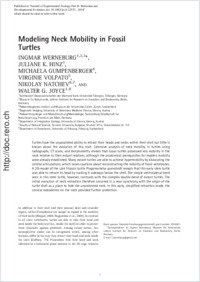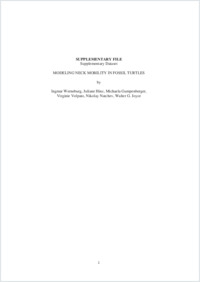Modeling neck mobility in fossil turtles
- Werneburg, Ingmar Fachbereich Geowissenschaften der Eberhard Karls Universität Tübingen, Germany - Museum für Naturkunde, Leibniz Institute for Research on Evolution and Biodiversity, Berlin, Germany - Paläontologisches Institut und Museum der Universität Zürich, Switzerland
- Hinz, Juliane K. Fachbereich Geowissenschaften der Eberhard Karls Universität Tübingen, Germany
- Gumpenberger, Michaela Diagnostic Imaging, University of Veterinary Medicine Vienna, Austria
- Volpato, Virginie Paläoanthropologie und Messelforschung/Mammalogie, Senckenberg Gesellschaft für Naturforschung, Frankfurt am Main, Germany
- Natchev, Nikolay Department of Integrative Zoology, University of Vienna, Austria - Faculty of Natural Science, Shumen University, Bulgaria
- Joyce, Walter G. Fachbereich Geowissenschaften der Eberhard Karls Universität Tübingen, Germany - Department of Geoscience, University of Fribourg, Switzerland
-
01.02.2014
Published in:
- Journal of Experimental Zoology Part B: Molecular and Developmental Evolution. - 2015, vol. 324, no. 3, p. 230-243
English
Turtles have the unparalleled ability to retract their heads and necks within their shell but little is known about the evolution of this trait. Extensive analysis of neck mobility in turtles using radiographs, CT scans, and morphometry reveals that basal turtles possessed less mobility in the neck relative to their extant relatives, although the anatomical prerequisites for modern mobility were already established. Many extant turtles are able to achieve hypermobility by dislocating the central articulations, which raises cautions about reconstructing the mobility of fossil vertebrates. A 3D-model of the Late Triassic turtle Proganochelys quenstedti reveals that this early stem turtle was able to retract its head by tucking it sideways below the shell. The simple ventrolateral bend seen in this stem turtle, however, contrasts with the complex double-bend of extant turtles. The initial evolution of neck retraction therefore occurred in a near-synchrony with the origin of the turtle shell as a place to hide the unprotected neck. In this early, simplified retraction mode, the conical osteoderms on the neck provided further protection.
- Faculty
- Faculté des sciences et de médecine
- Department
- Département de Géosciences
- Language
-
- English
- Classification
- Palaeontology
- License
-
License undefined
- Identifiers
-
- RERO DOC 210039
- DOI 10.1002/jez.b.22557
- Persistent URL
- https://folia.unifr.ch/unifr/documents/303564
Other files
Statistics
Document views: 208
File downloads:
- pdf: 421
- Supplementary material: 177

